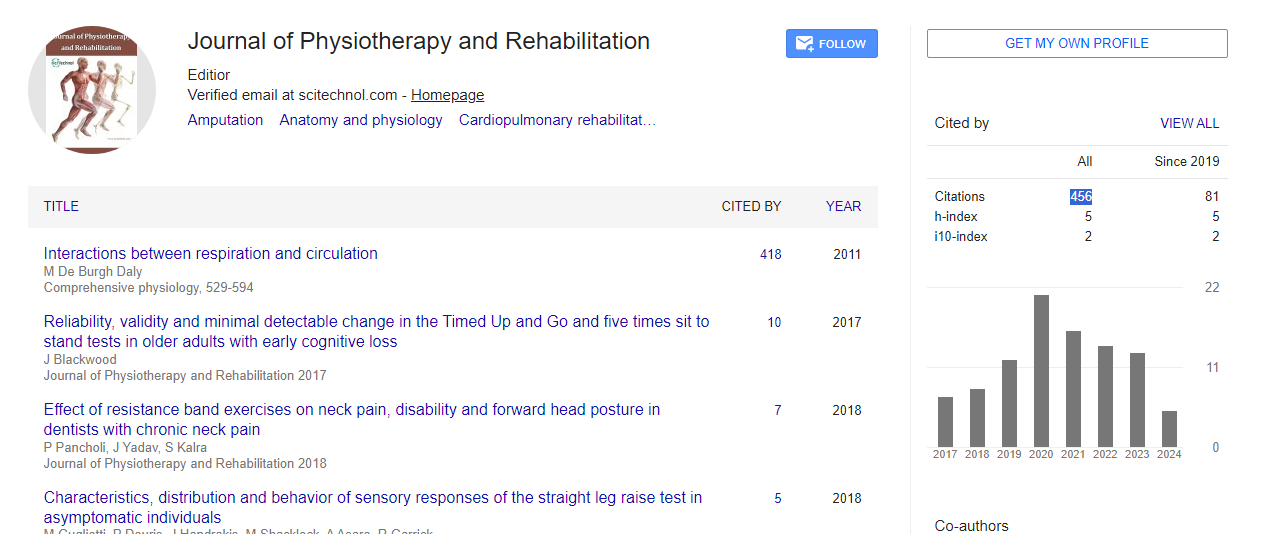Opinion Article, J Physiother Rehabil Vol: 5 Issue: 12
A Note Pregnancy and the Risk of Miscarriage
Cunningham C*
Department of Statistics and Medical Gerontology, Trinity University, Leixlip, Ireland
*Corresponding author: Cunningham C, Departments of Statistics and Medical Gerontology, Trinity University, Leixlip, Ireland, E-mail: Neva.Kirk@gmail.com
Received date: 01 December, 2021; Accepted date: 16 December, 2021; Published date: 23 December, 2021
Citation: Cunningham C (2021) A Note Pregnancy and the Risk of Miscarriage. J Physiother Rehabi 5:12
Abstract
To study the effect of magnetic fields on the risk of miscarriage, we conducted a population-based prospective cohort study among pregnant women within a large health maintenance organization. All women with a positive pregnancy test at less than 10 weeks of gestation and residing in the San Francisco area were contacted for participation in the study. We conducted in-person interviews to obtain information on risk factors for miscarriage and other potential confounders. All participants were also asked to wear a magnetic field-measuring meter for 24 hours and to keep a diary of their activities. Pregnancy outcomes were obtained for all participants by searching the health maintenance organization’s databases, reviewing medical charts, and telephone follow-up. We used the Cox proportional hazard model for examining the magnetic fieldmiscarriage association. A total of 969 subjects were included in the final analyses.
Keywords: Pregnancy, Miscarriage, Spontaneous Abortion
Description
To study the effect of magnetic fields on the risk of miscarriage, we conducted a population-based prospective cohort study among pregnant women within a large health maintenance organization. All women with a positive pregnancy test at less than 10 weeks of gestation and residing in the San Francisco area were contacted for participation in the study. We conducted in-person interviews to obtain information on risk factors for miscarriage and other potential confounders. All participants were also asked to wear a magnetic field-measuring meter for 24 hours and to keep a diary of their activities. Pregnancy outcomes were obtained for all participants by searching the health maintenance organization’s databases, reviewing medical charts, and telephone follow-up. We used the Cox proportional hazard model for examining the magnetic fieldmiscarriage association. A total of 969 subjects were included in the final analyses.
Although we did not observe an association between miscarriage risk and the average magnetic field level, miscarriage risk increased with an increasing level of maximum magnetic field exposure with a threshold around 16 milligauss (mG). The rate ratio (RR) associated with magnetic field exposure ≥16 mG (vs <16 mG) was 1.8 [95% confidence interval (CI) = 1.2–2.7]. The risk remained elevated for levels (in tertiles) of maximum magnetic field exposure ≥16 mG. The association was stronger for early miscarriages (<10 weeks of gestation) (RR = 2.2, 95% CI = 1.2–4.0) and among “susceptible” women with multiple prior fetal losses or subfertility (RR = 3.1, 95% CI = 1.3–7.7).
After excluding women who indicated that their daily activity pattern during the measurements did not represent their typical daily activity during pregnancy, the association was strengthened; RR = 2.9 (95% CI = 1.6–5.3) for maximum magnetic field exposure ≥16 mG, RR = 5.7 (95% CI = 2.1–15.7) for early miscarriage, and RR = 4.0 (95% CI = 1.4–11.5) among the susceptible women. Our findings provide strong prospective evidence that prenatal maximum magnetic field exposure above a certain level (possibly around 16 mG) may be associated with miscarriage risk. This observed association is unlikely to be due to uncontrolled biases or unmeasured confounders.
Spontaneous Abortion
In A miscarriage, also called a spontaneous abortion, is the unexpected ending of a pregnancy. About 1/3 to 1/2 of all pregnancies end in miscarriage before a person misses a menstrual period or even knows they are pregnant. About 10 to 20% of people who know they are pregnant will miscarry. A miscarriage is most likely to occur within the first 3 three months of pregnancy, before 20 weeks’ gestation. Only 1% of miscarriages occur after 20 weeks’ gestation. These are termed late miscarriages. About half of all miscarriages that occur in the first trimester are caused by chromosomal abnormalities which might be hereditary or spontaneous in the parent's sperm or egg. Chromosomes are tiny structures inside the cells of the body that carry many genes, the basic units of heredity
Genes determine all of a person’s physical attributes, such as sex, hair and eye color and blood type. Most chromosomal problems occur by chance and are not related to the parents' health. Your healthcare provider will perform a pelvic exam and an ultrasound test to confirm the miscarriage. If the miscarriage is complete and the uterus is clear, then no further treatment is usually required. Occasionally, the uterus is not completely emptied, so a dilation and curettage (D&C) or dilation and extraction (D&E) procedure is performed. During these procedures, the cervix is dilated and any remaining fetal or placental tissue is gently scraped or suctioned out of the uterus. You will usually resume your menstrual period in about 4 to 6 weeks.
 Spanish
Spanish  Chinese
Chinese  Russian
Russian  German
German  French
French  Japanese
Japanese  Portuguese
Portuguese  Hindi
Hindi 